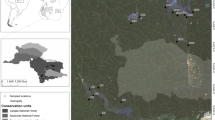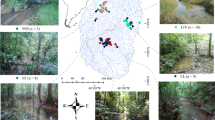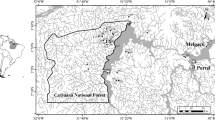Abstract
The distribution and composition of aquatic insect communities in streams at a local scale are considered to be primarily determined by environmental factors and interactive relationships within the system. Here, we evaluated the effects of forest fragmentation and forest cover changes on habitat characteristics of streamlets (igarapés) in Amazonian forests and on the aquatic insect communities found there. We also developed a habitat integrity index (HII) based on Petersen’s protocol (1992) to evaluate physical integrity of these streamlets and to determine its efficiency to interpret the environmental impacts on this system. We studied 20 small streams at the Biological Dynamics of Forest Fragments Project (BDFFP INPA/SI) study areas, Central Amazonia, 80 km north of Manaus, Amazonas State, Brazil. The vegetation cover was estimated by using LANDSAT images and classified in the following categories: exposed soil, pastures, secondary forests (capoeiras), and primary forests. Stream habitat features were evaluated by using a HII based on visual assessment of local characteristics. Aquatic insects were sampled in four major stream substrates: litter deposited in pools or backwaters, litter retained in riffles, sand, and marginal banks. Stream habitat characteristics were significantly correlated to land use and riparian forest condition. Overall aquatic insect richness and Ephemeroptera, Plecoptera, and Trichoptera (EPT) richness were significantly lower in pasture streams, and their taxonomic composition differed significantly from streams in forested areas. However, these metrics were not significantly correlated to the stream HII. Taxonomic composition of bank insect assemblages changed significantly between streams with low and high values of HII. There was no significant relationship between the proportion of primary forest cover and the faunal metrics. Only drastic changes in the vegetal cover seem to induce significant changes in the aquatic insect community. Matrix habitat heterogeneity, distance to forest fragments, the presence of areas of secondary forest, and the intrinsic capacity to disperse in many of the insect groups may have contributed to attenuate the effects of habitat disturbance on aquatic insect assemblages in streamlets.






Similar content being viewed by others
References
Adams, J. B., D. E. Sabol, V. Kapos, D. A. Roberts, M. O. Smith & A. R. Gillespie, 1995. Classification of multispectral images based on fractions of end members: Application to land-cover change in the Brazilian Amazon. Remote Sensing of Environment 52: 137–154.
Allan, D., D. L. Erickson & J. Fay, 1997. The influence of catchment land use on stream integrity across multiple spatial scales. Freshwater Biology 37: 149–161.
Alves, S. D. & D. Skole, 1996. Characterizing land cover dynamics using multi-temporal imagery. International Journal of Remote Sensing 17: 835–839.
Anbumozhi, V., J. Radhakrishnan & E. Yamaji, 2005. Impact of riparian buffer zones on water quality and associated management considerations. Ecological Engineering 24: 517–523.
Angrisano E. B., 1995. Insecta Trichoptera. In Lopretto, E. C. & G. Tell (eds), Ecosistemas de Águas Continentales. Ed. SUR, La Plata: 1199–1238.
Barbour, M. T., J. Gerritsen, G. E. Griffith, R. Frydenborg, E. McCarron, J. S. White & M. L. Bastian, 1996. A framework for biological criteria for Florida streams using benthic macroinvertebrates. Journal of the North American Benthological Society 15: 185–211.
Barbour, M. T., J. Gerritsen, B. D. Snyder & J. B. Stribling, 1999. Rapid Bioassessment Protocols for Use in Streams & Wadeable Rivers: Periphyton, Benthic Macroinvertebrates & Fish, 2nd edn. United States Environmental Protection Agency, EPA, 841-B-99-002, Washington DC.
Belle, J., 1992. Studies on ultimate instar larvae of Neotropical Gomphidae, with description of Tibiagomphus gen. nov. (Anisoptera). Odonatologica 2: 1–25.
Benstead, J. P. & C. M. Pringle, 2004. Deforestation alters the resource base and biomass of endemic stream insects in eastern Madagascar. Freshwater Biology 49: 490–501.
Benstead, J. P., M. M. Douglas & C. M. Pringle, 2003. Relationships of stream invertebrate communities to deforestation in eastern Madagascar. Ecological Applications 13: 1473–1490.
Benjamini, Y. & Y. Hochberg, 1995. Controlling the false discovery rate: A practical and powerful approach to multiple testing. Journal of the Royal Statistical Society B 57: 289–300.
Bierregaard, R. O., Jr., C. Gascon, T. E. Lovejoy & R. Mesquita (eds), 2001. Lessons from Amazonia: The Ecology and Conservation of a Fragmented Forest. Yale University Press, New Haven.
Bilton, D. T., J. R. Freeland & B. Okamura, 2001. Dispersal in freshwater invertebrates. Annual Review of Ecology and Systematics 32: 159–181.
Carvalho, A. L. & E. R. Calil, 2000. Chaves de identificação para as famílias de Odonata (Insecta) ocorrentes no Brasil, adultos e larvas. Papéis Avulsos de Zoologia 41: 223–241.
Church, M., 2002. Geomorphic thresholds in riverine landscapes. Freshwater Biology 47: 541–557.
Gotelli, N. & R. K. Colwell, 2001. Quantifying biodiversity: Procedures and pitfalls in the measurement and comparison of species richness. Ecology Letters 4: 379–391.
Da Silva, E. R., F. F. Salles, J. L. Nessimian & L. B. N. Coelho, 2003. A identificação das famílias de Ephemeroptera (Insecta) ocorrentes no Estado do Rio de Janeiro: Chave pictórica para as ninfas. Boletim do Museu Nacional 508: 1–6.
Davidson, E. A., C. Neill, A. V. Krusche, V. V. R. Ballester, D. Markewitz & R. O. Figueiredo, 2004. Loss of nutrients from terrestrial ecosystems to streams and the atmosphere following land use change in Amazonia. In Ecosystems and Land Use Change. Geophysical Monograph Series: 147–158.
Davies, P. E., L. S. J. Cook, P. D. McIntosh & S. A. Munks, 2005. Changes in stream biota along a gradient of logging disturbance, 15 years after logging at Ben Nevis, Tasmania. Forest Ecology and Management 219: 132–148.
De Long, M. D. & M. A. Brusven, 1994. Allochthonous imput of organic matter from different riparian habitats of an agriculturally impacted stream. Environmental Management 18: 59–71.
Egler, M., 2002. Utilizando a comunidade de macroinvertebrados bentônicos na avaliação da degradação de ecossistemas de rios em áreas agrícolas. Master’s Thesis, ENSP, FIOCRUZ, Rio de Janeiro.
Elliott, J. M., 2003. A comparative study of the dispersal of 10 species of stream invertebrates. Freshwater Biology 48: 1652–1668.
Fossati, O., J. G. Wasson, C. Hery, R. Marin & G. Salinas, 2001. Impact of sediment releases on water chemistry and macroinvertebrate communities in clear water Andean streams (Bolivia). Archiv für Hydrobiologie 151: 33–50.
De Lima, M. G. & C. Gascon, 1999. The conservation value of linear forest remnants in Central Amazonia. Biological Conservation 91: 241–247.
Dufrêne, M. & P. Legendre, 1997. Species assemblages and indicator species: The need for a flexible asymmetrical approach. Ecological Monographs 67: 345–366.
Fidelis da Silva, L. 2006. Estrutura da comunidade de insetos aquáticos em igarapés na Amazônia Central, com diferentes graus de preservação da cobertura vegetal e apresentação de chave de identificação para gêneros de larvas da ordem Odonata. Master’s Thesis, UFAM/INPA, Manaus.
García, L. V., 2004. Escaping the Bonferroni iron claw in ecological studies. Oikos 105: 657–663.
Gascon, C. & R. O. Bierregaard Jr., 2001. The Biological dynamics of forest fragments project—The study site, experimental design and research activity. In Bierregaard, R. O., Jr., C. Gascon, T. E. Lovejoy & R. Mesquita (eds), Lessons from Amazonia: The Ecology and Conservation of a Fragmented Forest. Yale University Press, New Haven: 31–45.
Gascon, C., W. F. Lawrence & T. E. Lovejoy, 2001. Fragmentação florestal e biodiversidade na Amazônia Central. In Garay, I. & B. F. S. Dias (orgs), Conservação da biodiversidade em ecossistemas tropicais: avanços conceituais e revisão de novas metotologias de avaliação e monitoramento. Editora Vozes, Petrópolis: 112–127.
Gordon, N. D., T. A. McMahon & B. L. Finlayson, 1992. Stream hydrology. An introduction for ecologists. John Wiley & Sons, Chichester.
Hammer, O., D. A. T. Harper & P. D. Ryan, 2001. Past. Paleontological statistic software for education and data analysis. Paleontologia Eletronica 4(1): 9 pp.
Harding, J. S., R. G. Young, J. W. Hayes, K. A. Shearer & J. D. Stark, 1999 Changes in agricultural intensity and river health along a river continuum. Freshwater Biology 42: 345–357.
Lawrence, W. F., 2001. The Hyper-Diverse Flora of the Central Amazon: An Overview. In Bierregaard, R. O. Jr., C. Gascon, T. E. Lovejoy & R. Mesquita (eds), Lessons from Amazonia: The Ecology and Conservation of a fragmented forest. Yale University Press, New Haven and London: 47–53.
Lovejoy, T. E., R. O. Bierregaard, J. M. Rankin & H. O. R. Schubart, 1983. Ecological dynamics of tropical forest fragments. In Sutton, S. L., T. C. Whitmore & A. C. Chadwick (eds) Tropical Rain Forest: Ecology and Management. Blackwell Scientific Publication, Oxford: 377–384.
Macneale, K. H., B. L. Peckarsky & G. E. Likens, 2005. Stable isotopes identify dispersal patterns of stonefly populations living along stream corridors. Freshwater Biology 50: 1117–1130.
Malmqvist, B., 2002. Aquatic invertebrates in riverine landscapes. Freshwater Biology 47: 679–694.
Manzo, V., 2005. Key to the South America of Elmidae (Insecta: Coleoptera) with distributional data. Studies of Neotropical Fauna and Environment 40: 201–208.
McClain, M. E. & H. Elsenbeer, 2001. Terrestrial inputs to Amazon streams and internal biogeochemical processing. In McClain, M. E., E. Victoria & J. Rishey (eds), The Biogeochemistry of the Amazon Basin. Oxford University Press, Oxford: 185–207.
McCune, B. & M. J. Mefford, 1999. Multivariate Analysis of Ecological Data. Version 4.14 MjM Software, Gleneden Beach, Oregon.
Melo, E. G. F., M. S. R. Silva & S. A. F. Miranda, 2005. Influência antrópica sobre águas de igarapés na cidade de Manaus – Amazonas. Caminhos de Geografia 5: 40–47.
Mendonça, F. P., W. E. Magnusson & J. Zuanon, 2005. Relationships between habitat characteristics and fish assemblages in small streams of Central Amazonia. Copeia 4: 750–763.
Merritt, R. W. & K. W. Cummins (eds), 1996. An Introduction to the Aquatic Insects of North America. Kendall/Hunt Publishing Company, Dubuque.
Mol, J. H. & P. E. Ouboter, 2004. Downstream effects of erosion from small-scale gold mining on the instream habitat and fish community of a small neotropical rainforest stream. Conservation Biology 18: 201–214.
Moreira, M. P., 2002. O uso de sensoriamento remoto para avaliar a dinâmica de sucessão secundária na Amazônia Central. Master’s Thesis, INPA/UFAM, Manaus.
Mortati, A. F., 2004. Colonização por peixes no folhiço submerso: implicações das mudanças na cobertura florestal sobre a dinâmica da ictiofauna de igarapés na Amazônia Central. Master’s Thesis, INPA/UFAM, Manaus.
Naiman, R. J. & H. Decamps, 1997. The ecology of interfaces: Riparian zones. Annual Review of Ecology and Systematics 28: 621–658.
Nakamura, F. & H. Yamada, 2005. Effects of pasture development on the ecological functions of riparian forests in Hokkaido in northern Japan. Ecological Engineering 24: 539–550.
Nerbone, B. A. & B. Vondracek, 2001 Effects of local land use on physical habitat, benthic macoinvertebrates and fish in the Whitewater River, Minesota, USA. Environmental Management 28: 87–99.
Nieser, N. & A. L. Melo, 1997. Os heterópteros aquáticos de Minas Gerais. Editora UFMG, Belo Horizonte.
Olifiers, M. H., L F. M. Dorvillé, J. L. Nessimian & N. Hamada, 2004. A key to Brazilian genera of Plecoptera (Insecta) based on nymphs. Zootaxa 651: 1–15.
Oliveira, A. A. & S. Mori, 1999. A central Amazonian terra firme forest. I. High tree species richness on poor soils. Biodiversity and Conservation 8: 1219–1244.
Pes, A. M. O., N. Hamada & J. L. Nessimian, 2005. Chaves de identificação de larvas para famílias e gêneros de Trichoptera (Insecta) da Amazônia Central, Brasil. Revista Brasileira de Entomologia 49: 181–204.
Petersen, R. C., Jr., 1992. The RCE: A riparian, channel, and environmental inventory for small streams in agricultural landscape. Freshwater Biology 27: 295–306.
Petersen, I., Z. Masters, A. G. Hildrew & S. J. Ormerod, 2004. Dispersal of adult aquatic insects in catchments of differing land use. Journal of Applied Ecology 41: 934–950.
Price, P. & D. S. Leigh, 2006. Morphological and sedimentological responses of streams to human impact in the southern Blue Ridge Mountains, USA. Geomorphology 78: 142–160.
Pozo, J., E. González, J. R. Díez, J. Molinero & A. Elósegui, 1997. Inputs of particulate organic matter to streams with different riparian vegetation. Journal of the North American Benthological Society 16: 602–611.
Roque, F. O. & S. Trivinho-Strixino, 2000. Fragmentação de habitats nos córregos do Parque Estadual do Jaraguá (SP): Possíveis impactos na riqueza de macroinvertebrados e considerações para conservação in situ. In Anais do II Congresso Brasileiro de Unidades de Conservação, Campo Grande: 752–760.
Roque, F. O., S. Trivinho-Strixino, G. Strixino, R.C. Agostinho & J. C. Fogo, 2003. Benthic macroinvertebrates in streams of Jaragua State Park (Southeast of Brazil) considering multiple spatial scale. Journal of Insect Conservation 7: 63–72.
Roy, A. H., A. D. Rosemond, D.S. Leigh, M. J. Paul & B. Wallace, 2003. Habitat-specific responses of stream insects to land cover disturbance: Biological consequences and monitoring implications. Journal of North American Benthological Society 22: 292–307.
Sanderson, R. A., M. D. Eyre & S. P. Rushton, 2005. The influence of stream invertebrate composition at neighbouring sites on local assemblage composition. Freshwater Biology 50: 221–231.
Silveira, M. P., D. F. Baptista, D. F. Buss, J. L. Nessimian & M. Egler, 2005. Application of biological measures for stream integrity assessment in south-east Brazil. Environmental Monitoring and Assessment 101: 117–128.
Sizer, N. C., 1992. The impact of edge formation on regeneration and litterfall in a tropical rain forest fragment in Amazonia. Ph.D. Thesis, University of Cambridge, Cambridge.
Sparovek, G., S. B. L. Ranieri, A. Gassner, I. C. De Maria, E. Schnug, R. F. Santos & A. Joubert, 2002. A conceptual framework for definition of the optimal width of riparian forests. Agriculture Ecosystems and Environment 90: 169–175.
Smith, N. J. H., E. A. S. Serrão, P. T. Alvim & I. C. Falesi, 1995. Amazônia: Resiliency and dynamism of the land and its people. United Nations University Press, Tokyo.
StatSoft, Inc., (2001). STATISTICA (data analysis software system), version 6.
Steininger, M. K., 1996. Tropical secondary forest regrowth in the Amazon: Age, area, and change estimation with Thematic Mapper data. International Journal of Remote Sensing 17: 9–27.
Vannote, R. L., G. W. Minshall, K.W. Cummins, J. R. Sedell & C. Cushing, 1980. The river continuum concept. Canadian Journal of Fisheries and Aquatic Sciences 37: 130–137.
Walker, R., W. Salas, G. Urquhart, M. Keller, D. Skole & M. Pedlowski (orgs), 1999. Secondary vegetation: ecological, social, and remote sensing issues. Report on the workshop. “Measurement and Modeling of the Inter-Annual Dynamics of Deforestation and Regrowth in the Brazilian Amazon”. Florida State University.
Webster, J. R., S. W. Golladay, E. F. Benfield, D. J. D’Angelo & G. T. Peters, 1990. Effects of forest disturbance on particulate organic matter budgets of small streams. Journal of North American Benthological Society 9: 120–140.
Wiggins, G. B., 1996. Larvae of North American caddisfly genera (Trichoptera), 2nd edn. University of Toronto Press, Toronto.
Williamson, G. B., R. C. G. Mesquita, K. Ickes & G. Ganade, 1998. Estratégias de árvores pioneiras nos Neotrópicos. In Gascon, C. & P. Moutinho (eds), Floresta Amazônica: Dinâmica, Regeneração e Manejo. Instituto Nacional de Pesquisas da Amazônia (INPA), Manaus, Amazonas, Brazil: 131–144.
Wood, P. J. & P. D. Armitage, 1997. Biological effects of fine sediment in the lotic environment. Environmental Management 21: 203–207.
Zuanon, J. & I. Sazima. 2004. Natural history of Stauroglanis gouldingi (Siluriformes: Trichomycteridae), a miniature sand-dwelling candiru from central Amazonia streamlets. Ichthyological Exploration of Freshwaters 15: 201–208.
Zweig, L. D. & C. H. Rabeni, 2001. Biomonitoring for deposited sediment using benthic invertebrates: A test on 4 Missouri streams. Journal of the North American Benthological Society 20: 643–657.
Acknowledgments
This work was supported by the BDFFP, FAPEAM PIPT 2004–2006, Fundação O Boticário de Proteção à Natureza (0630_20041), and CNPq (Edital Universal 2005–2007). We thank Ocírio Pereira and José Ribamar Marques de Oliveira for invaluable field assistance. Ana Maria Oliveira Pes (DCEN, INPA), Alcimar do Lago Carvalho (Museu Nacional, UFRJ), Elidiomar Ribeiro da Silva (UNI-RIO), and Maria Inês da Silva dos Passos (IB, UFRJ) helped with the identification of the insects. Darcílio Fernandes Baptista (FIOCRUZ) provided valuable comments and suggestions on this manuscript. Daniela Maeda Takiya (UFPR) revised the final English text. The manuscript was greatly improved by comments and critical reviews from Dr. Joel Trexler and two anonymous referees. This is contribution number 09 of Igarapés Project and contribution number 515 of the BDFFP Technical Series.
Author information
Authors and Affiliations
Corresponding author
Additional information
Publication number 515 of the PDBFF Technical Series. PDBFF-INPA/STRI (Biological Dynamics of Forest Fragments Project, Instituto Nacional de Pesquisas da Amazonia and Smithsonian Tropical Research Institute) and number 09 of the Igarapés Project.
Handling editor: J. Trexler
Electronic supplementary material
Below is the link to the electronic supplementary material.
Rights and permissions
About this article
Cite this article
Nessimian, J.L., Venticinque, E.M., Zuanon, J. et al. Land use, habitat integrity, and aquatic insect assemblages in Central Amazonian streams. Hydrobiologia 614, 117–131 (2008). https://doi.org/10.1007/s10750-008-9441-x
Received:
Revised:
Accepted:
Published:
Issue Date:
DOI: https://doi.org/10.1007/s10750-008-9441-x




